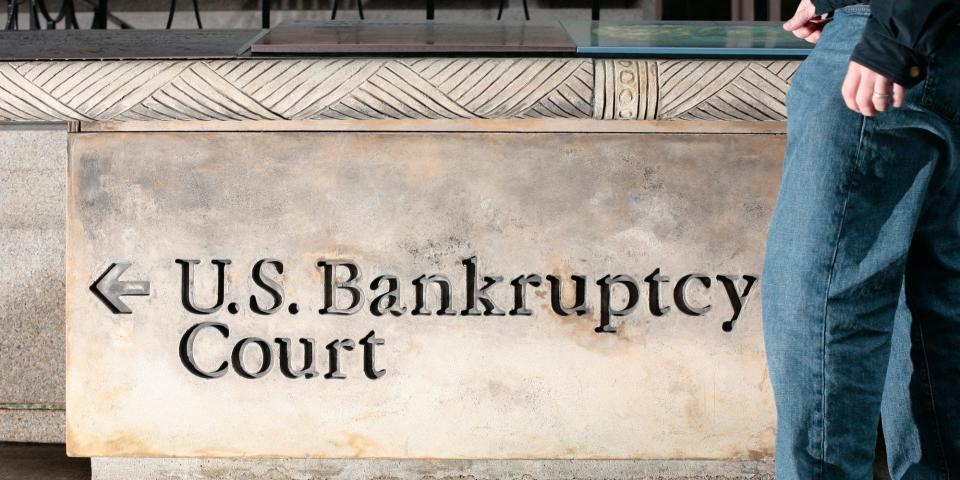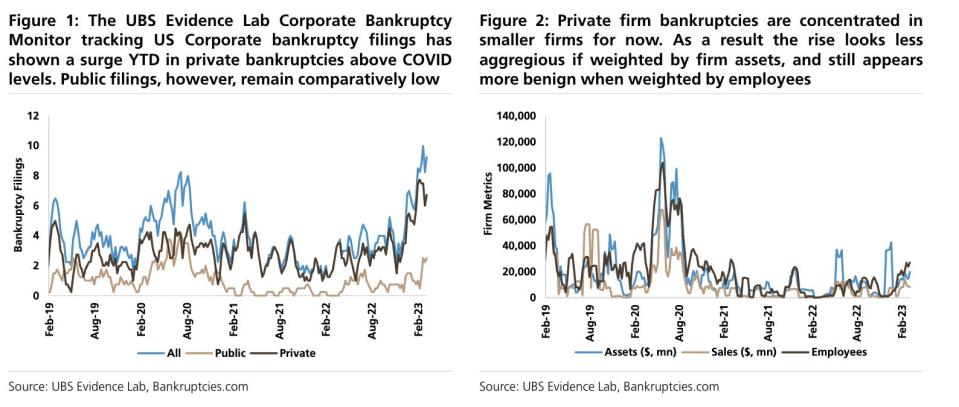[ad_1]

-
Private bankruptcy filings this year have surpassed a peak set in the early stage of the pandemic, UBS said.
-
Bankruptcies were on the rise before the banking turmoil caused by the collapse of SVB and Signature Bank.
-
Rising bankruptcies among smaller businesses are “underappreciated signs of distress in US corporate credit.”
Warning signs of a potential credit crunch were flashing even before Silicon Valley Bank’s stunning collapse, as this year sees record high bankruptcy filings by small- to mid-sized private businesses, according to UBS.
Financial markets this month were whipped around after the biggest bank failure since the global financial crisis highlighted worries about the impact of tighter credit conditions for American businesses and consumers.
[“We] believe one of the more underappreciated signs of distress in US corporate credit is already emanating from the Small and Mid-size Enterprises sector,” Matthew Mish, head of credit strategy at UBS, wrote in a recently published research note.
Some of the “smallest of firms facing the most severe pressure from rising rates, persistent inflation and slowing growth,” said Mish.
So far in 2023, private bankruptcy filings have outstripped a peak set in the early stage of the COVID pandemic by a wide margin. The four-week moving average of 7.8 in late February towered over the 4.5 moving average in June 2020, UBS Evidence Lab said in the note.
Bankruptcy hot spots include the real estate industry, which has led this year’s increase in private bankruptcy filings. The healthcare sector, meanwhile, is among the ones to watch for signs that credit stress is pushing into US labor markets, global strategists at the Swiss investment bank said.
The weekly data collected by UBS flicks to worrisome trends about smaller business going belly-up even before the month’s banking industry shakeup stemming from the failures of SVB and crypto-friendly Signature Bank.
The FDIC is facing more than $20 billion in costs after coming to the rescue of depositors at those banks, stoking concerns that other small banks will come under liquidity stress and pull back on lending to businesses and retail clients.
Smaller and regional banks are “critical” to small and medium-sized businesses as they hold 40% of loans and debt at those companies, said UBS. Companies with fewer than 500 staff members make up 58% of the privately employed workforce in the US, Pantheon Macroeconomics recently wrote, underscoring the key role those businesses hold in the world’s largest economy.
Fiscal stimulus and the Federal Reserve’s Main Street Lending Program did suppress bankruptcy filings in 2020, but “the YTD spike is nevertheless stark – outright and relative to public filings – and a clear indication that a fulcrum of credit stress this cycle is in smaller corporates,” Mish said.
Sector watch
“Fortunately, at this stage, the concerning trend in private filings does not appear to have spilled over to the US labor market,” Mish added.
The UBS Evidence Lab Corporate Bankruptcy Monitor tracks US corporate chapter 7, 11, and 15 bankruptcy filings. After sifting through data, UBS outlined several takeaways, including that private bankruptcy filings are led by the real estate, chemicals, healthcare, and retail industries.
UBS also mapped out the top 15 sectors by filings year-to-date to data from the Bureau of Labor Statistics as a percentage of private sector employment. “The results suggest healthcare, retail, construction, restaurant and financial sectors will be key to watch moving forward.”
Federal Reserve Bank of Minneapolis President Neel Kashkari said this week that it was too early to determine whether SVB’s implosion will lead to a credit crunch.
“What’s unclear right now is how much of the banking stresses of the past few weeks is leading to a sustained credit crunch which would then slow down the US economy,” Kashkari said at townhall in St. Paul, Minnesota, on Thursday, according to Bloomberg.
Banks, on average, “have a lot of capital” and the Fed with other regulators is there to support the banking system, Kashkari said. “So that should give us all confidence. It’s going to take us a while until we fully understand, are there more losses out there,” the Fed official said.

Read the original article on Business Insider
[ad_2]
Source link
